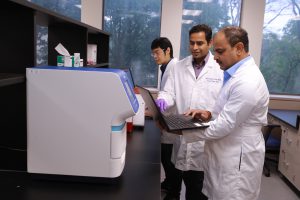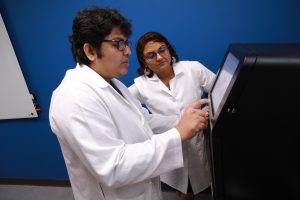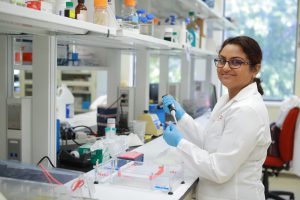Author Archive
NIH doctor to give Hussain lecture on connecting body, mind and spirit to heal
Tuesday, October 23rd, 2018It’s only recently in the great history of medicine that a disease could genuinely be cured. Hippocrates practiced 2,500 years ago, but simple antibacterial drugs that could knock out illnesses like pneumonia or strep throat weren’t widely available until the late 1940s.
With cures elusive, the focus of physicians was doing what they could to make the patient whole. That mission is still important today, said Dr. Ann Berger, chief of Pain and Palliative Care at the National Institutes of Health Clinical Center who is speaking at The University of Toledo this week.
“In medicine there can be healing or curing. Most illnesses at this point in time we are not actually curing,” Berger said. “But what we can do in medicine is help people heal. The common thread of healing is putting together mind, body and spirit. Even when we do cure patients, trying to help the person reach psychosocial spiritual healing is extremely important and desired by the patient.”
Berger will discuss the theory and history of healing in a lecture titled “The Importance of Psychosocial Spiritual Healing in Healthcare” as the featured speaker Thursday, Oct. 25, at the 10th annual S. Amjad Hussain Visiting Lecture in the History of Medicine and Surgery at UT.

Dr. Ann Berger, chief of Pain and Palliative Care at the National Institutes of Health Clinical Center.
The lecture, which begins at 5 p.m. in Collier Building Room 1000 on UT’s Health Science Campus, is free and open to the public.
A 1988 graduate of the Medical College of Ohio, Berger helped shape the field of palliative care. She lectures nationally and internationally and has published extensively in the field. Berger also edited the first textbook on palliative care and supportive oncology in the country.
She has been chief of Pain and Palliative Care at the NIH Clinical Center since 2000.
Berger said there is a long string running throughout the history of healing medicine that link the same ideas of connecting the mind, body and spirit.
“If you go through all the world’s different cultures, from traditional Chinese medicine to Native American medicine, you see this,” Berger said. “We’ll not only talk about how different cultures thought about healing, but we’ll also discuss what we can do as health-care professionals and how healing occurs by doing something intentionally.”
The S. Amjad Hussain Visiting Lecture in the History of Medicine and Surgery was created in honor of Dr. Hussain, professor emeritus of cardiovascular surgery and humanities, a former member of the UT Board of Trustees and columnist for The Blade.
“She is a graduate of our medical school and has made a name for herself in palliative care, which has become a well-recognized specialty in the practice of medicine,” Hussain said. “To bring in someone who is the head of a federal agency in charge of this particular specialty is great for us at The University of Toledo.”
RSVPs are requested; email hscevents@utoledo.edu or call 419.383.6300.
UT research finds link between refined dietary fiber, gut bacteria and liver cancer
Thursday, October 18th, 2018Many of the processed foods we find on grocery store shelves have been loaded up with highly refined soluble fibers such as inulin, a popular probiotic that recently received approval from the Food and Drug Administration to be marketed as health-promoting.
But a new study from The University of Toledo’s College of Medicine and Life Sciences is raising serious questions about whether the risks of adding refined fiber to processed foods may significantly outweigh the benefits.
Dr. Matam Vijay-Kumar, director of the UT Microbiome Consortium and associate professor in the UT Department of Physiology and Pharmacology, and his research team recently investigated if a diet enriched with refined inulin might help combat obesity-associated complications in mice.
While the inulin-containing diet did stave off obesity in 40 percent of mice, many of those same mice went on to develop liver cancer at the end of the six-month study.
“The findings shook us,” Vijay-Kumar said, “but at the same time we recognized their potential importance and accepted the challenge of exploring how processed dietary soluble fiber was inducing liver cancer.”
Although this study was performed in mice, it has potential implications for human health. It also suggests, researchers say, that enriching processed foods with refined, fermentable fiber should be approached with great caution.
“We fully appreciate that the fibers present in whole foods like fruits and vegetables are healthy,” Vijay-Kumar said. “Because of that, fortifying or adding purified fiber to processed food sounds logical. However, our results suggest it may in fact be dangerous.”

Dr. Vishal Singh, center, a Crohn’s and Colitis Foundation Fellow at The University of Toledo, recently authored a study published in the journal Cell that found a link between highly refined soluble fibers and liver cancer. He is pictured with fellow researchers Beng San Yeoh, left, a PhD student, and Dr. Matam Vijay-Kumar, right, director of the UT Microbiome Consortium and associate professor in the UT Department of Physiology and Pharmacology.
The findings were published in the Oct. 18 issue of Cell, one of the world’s leading biological journals.
There are two basic types of naturally occurring dietary fiber, soluble and insoluble. Soluble fibers are fermented by gut bacteria into short-chain fatty acids. Insoluble fibers pass through the digestive system unchanged.
While both types are beneficial, the concern raised in the study relates to how gut bacteria break down the highly refined fiber that is added to some processed foods as a dietary supplement.
Dr. Vishal Singh, a Crohn’s and Colitis Foundation Fellow at The University of Toledo and lead author of the paper, said refined fiber is a new addition to our diets and that we are in the very early stages of understanding the risks and benefits it may present.
“Soluble fibers added to processed foods are not part of a natural meal,” Singh said. “The inulin used in this study is from chicory root, which is not a food we would normally eat. In addition, during the extraction and processing of the fiber, it goes through a chemical process. We don’t know how the body responds to these processed fibers.”
Chicory root is used as a source of inulin to fortify fiber in processed foods.
The mice that developed liver cancer in this study had altered and elevated gut bacteria, a condition known as dysbiosis. Intriguingly, the researchers observed no evidence of liver cancer in inulin-fed mice that were treated with broad-spectrum antibiotics to deplete gut bacteria.
The UT researchers collaborated with researchers at Georgia State University who performed a similar study in germ-free mice that completely lack gut bacteria. The absence of liver cancer in those mice further confirmed the contributory role of gut bacteria.
The bacteria collectively known as gut microbiota degrade and digest soluble fibers via fermentation. To inhibit that fermentation process, the UT researchers fed mice beta acids derived from Humulus lupulus — a plant more commonly known for producing the hops that go into beer to prevent spoilage from fermentation.
“Strikingly, feeding beta-acids to inulin-fed mice averted liver cancer, which further reinforces our hypothesis that gut bacterial dysmetabolism primarily driving liver cancer in these mice,” Singh said.
Researchers also found they could halt the development of liver cancer by intervening to replace inulin with the insoluble fiber cellulose.
“Cellulose could not be fermented by gut bacteria present in mice or humans. This finding again highlights the link between bacterial fermentation of soluble fiber and liver cancer development in these mice,” said Beng San Yeoh, a graduate student in Vijay-Kumar’s lab and another lead author of the study.
Researchers say their findings suggest the need for more studies that look at human consumption of the type of refined fiber found in processed foods.
“Our study is going against the conventional wisdom of what people think, that fiber is good, no matter how they get it,” Vijay-Kumar said. “We do not want to promote that fiber is bad. Rather, we highlight that fortifying processed foods with refined soluble fiber may not be safe or advisable to certain individuals with gut bacterial overgrowth or dysbiosis, whose abnormal fermentation of this fiber could increase the susceptibly to liver cancer.”
The study was supported by the National Cancer Institute of the National Institutes of Health.
Eleanor N. Dana Cancer Center to offer free breast cancer screenings, panel discussion on latest precision medicine treatments
Wednesday, October 17th, 2018The Eleanor N. Dana Cancer Center at The University of Toledo Medical Center is recognizing National Breast Cancer Awareness Month with free events aimed at early detection and education about the disease.
“Breast Cancer Awareness Month is a good time to think about having your mammogram,” said Jan Tipton, a registered nurse and manager of the Infusion Center at the Dana Cancer Center.
On National Mammography Day, which this year falls on Friday, Oct. 19, the Dana Cancer Center is offering free mammograms and clinical breast exams for women who are uninsured or underinsured.
One in eight women will develop breast cancer in her lifetime, but statistics show that one-third of women over the age of 40 have not had a mammogram in the past two years.
“By doing regular screenings we can detect these cancers early and hopefully prevent patients from needing more invasive treatments,” Tipton said.
Women who have not had a recent mammogram or those who have found a lump during a self-breast exam are encouraged to register. A limited number of spots are available. To register or inquire about eligibility, call 419.383.5170.
Later this month the Dana Cancer Center will host a free panel discussion with three of its breast cancer specialists to talk about the precision treatment options available at The University of Toledo Medical Center.
The program will begin at 5:45 p.m. on Thursday, Oct. 25, and feature breast surgeon Dr. Heather Klepacz, medical oncologist Dr. Danae Hamouda and radiation oncologist Dr. Tangel Chang who will speak about the latest advances in breast cancer treatment, including the most individualized treatment available today. A question-and-answer session will follow.
“We are entering into a new age of state-of-the art care using precision targeted therapy. Drs. Klepacz, Hamouda and Chang are all outstanding physicians who are part of our family-centered multi-disciplinary care team,” said Dr. F. Charles Brunicardi, a surgical oncologist at UTMC and director of the Cancer Program in the UT College of Medicine and Life Sciences. “We are proud of the work the Eleanor N. Dana Cancer Center is doing and glad we can educate the community on the latest options in cancer care.”
The panel discussion is open to the public but reservations are requested by emailing danacancercenter@utoledo.edu or calling 419.383.5243.
A no-pain gain to fight hypertension: UT research finds way to mimic exercise’s blood pressure lowering effects
Tuesday, October 16th, 2018Couch potatoes rejoice — there might be a way to get the blood pressure lowering benefits of exercise in pill form.
Hypertension researchers at The University of Toledo have shown that by increasing the body’s supply of beta hydroxybutyrate, a chemical produced predominantly by the liver, it is possible to regulate high blood pressure without reducing sodium intake or increasing exercise.
“Our team found that high salt consumption lowered levels of circulating beta hydroxybutyrate. When we put beta hydroxybutyrate back in the system, normal blood pressure is restored,” said Dr. Bina Joe, Distinguished University Professor and chair of UT’s Department of Physiology and Pharmacology and director of the Center for Hypertension and Precision Medicine. “We have an opportunity to control salt-sensitive hypertension without exercising.”
The team’s findings were published Tuesday in the Oct. 16 issue of the life sciences journal Cell Reports.

Saroj Chakraborty, a fourth-year Ph.D. student at the University of Toledo, left, and Dr. Bina Joe, Distinguished University Professor and chair of UT’s Department of Physiology and Pharmacology.
Beta hydroxybutyrate is a ketone body produced in the liver from the metabolism of fatty acids. It had not been previously explored as a method for controlling blood pressure, but the UT researchers noted a number of intriguing connections between how the body produces beta hydroxybutyrate and environmental factors known to raise or lower blood pressure.
“As we searched through the literature we saw beta hydroxybutyrate has been observed increasing with exercise or calorie restriction. Both of those activities also reduce blood pressure. The key piece of our discovery is we now know that beta hydroxybutyrate decreases with salt consumption. This is a novel mechanism by which salt is tied to an increase in blood pressure,” said Saroj Chakraborty, a fourth-year PhD student in the UT Department of Physiology and Pharmacology and the paper’s lead author.
To test its hypothesis, the team led by Chakraborty and Joe developed a study in which they fed lab rats a chemical called 1,3-butanediol.
When that supplement reaches the liver, enzymes convert it to beta hydroxybutyrate. From there, it goes to the kidney where it was shown to reduce inflammation commonly associated with hypertension — and significantly decrease blood pressure in the process.
“By fixing the kidney it is indirectly contributing to the lowering of blood pressure. There could be many other organs that it is impacting,” Joe said. “We are studying the heart, blood vessels, brain and other organ systems. But this paper says that this molecule, predominately made in the liver, goes to the kidney, fixes kidney damage and controls your blood pressure.”
Joe noted that controlling function of the liver to regulate blood pressure is a new concept for researchers.
UT has received a provisional patent on the concept. Researchers in Joe’s lab next want to compare the level of beta hydroxybutyrate in hypertensive patients against those without high blood pressure. Further studies also will determine how much 1,3-butanediol is needed to modulate blood pressure and whether it might cause any potential damage to other organs.
Once the team collects that data, the researchers hope to secure funding for a clinical trial.
While lowering blood pressure without hitting the gym might sound appealing to those averse to breaking a sweat, it also could prove beneficial to those who aren’t able to exercise.
“There are certain patients who are not able to exercise for various reasons. This could prove to be a legitimate alternative for those individuals,” Chakraborty said.
$1 million gift from Hal and Susan Fetterman to expand UT research into pancreatic cancer
Thursday, October 11th, 2018Toledo businessman Hal Fetterman and his wife, Susan Fetterman, have pledged $1 million to The University of Toledo to fund new research into treatments for pancreatic cancer, the third leading cause of cancer death in the United States.
The donation is in honor of Hal Fetterman’s sister Joyce Schwyn and three close friends who lost their lives to pancreatic cancer.
“They were the ones who inspired me to go in this particular direction,” Fetterman said. “There are people passing away from pancreatic cancer all the time. The ultimate goal of this gift would be a cure for the disease.”
The Fetterman’s donation will establish the UTMC Pancreatic Cancer Research Innovation Fund. Half of the gift will be dedicated to recruiting a top-tier faculty researcher to the UT College of Medicine and Life Sciences. The remaining $500,000 will be split between covering the costs of an upcoming clinical drug trial at The University of Toledo Medical Center and supporting a grant competition among faculty cancer researchers.
“The University of Toledo is grateful for the incredible generosity of Hal and Susan Fetterman,” UT President Sharon L. Gaber said. “The Fettermans have been loyal supporters of UT for years, and this new investment in the University will support important advances in medical care.”
Pancreatic cancer is relatively rare accounting for just 3 percent of all new cancer cases in the United States, but it is to blame for 7 percent of all cancer deaths. According to the National Cancer Institute, only lung cancer and colon cancer kill more Americans than pancreatic cancer.
Dr. F. Charles Brunicardi, the John Howard Endowed Professor of Pancreatic Surgery and director of the cancer program in the College of Medicine and Life Sciences, said there is already promising research being done at UT and the Fettermans’ gift will take it to the next step.
“I’m deeply honored by the Fettermans’ generosity and their devotion toward finding better treatments for pancreatic cancer,” Brunicardi said. “We feel that we’re on the verge of a big breakthrough. We can cure mice of pancreatic cancer. What we need to now do is translate that into clinical trials, and this grant will allow us to do that.”
Fetterman felt it was important that someone make a sizeable donation to draw more attention to the cause and hopefully additional resources to advance treatment options.
“Somebody’s got to break the ice. I think that more people need to get involved with things like this,” Fetterman said. “It’s not necessarily wanting to leave a legacy, but I can’t take it with me. God’s been good to me. I didn’t go to college and I didn’t have wealthy parents. I’m basically a farm boy from out in Fulton County. I want to do what I can to help people have a better life.”
The Fettermans are longtime supporters of UT. In 2007, the couple donated $1 million to the UT athletic department to build an indoor multi-sport practice facility that would ultimately become the Fetterman Training Center. They also established the Scott Raymond Fetterman Memorial Scholarship Fund in 1996 for UT engineering students.
UT professor awarded $2.6 million research grant to further work examining link between gut bacteria and high blood pressure
Monday, September 10th, 2018A University of Toledo researcher recently received a $2.64 million grant from the National Heart, Lung and Blood Institute to continue her groundbreaking research into how the unique colonies of tiny microorganisms living in our gut can regulate our blood pressure — or lead to hypertension.
High blood pressure is one of the most common ailments among American adults. According to figures from the U.S. Centers for Disease Control and Prevention, one in three adults has hypertension. And only about half of those have their condition under control. But even those who are actively controlling their hypertension are frequently just masking the problem.

Dr. Bina Joe, Distinguished University Professor and chair of UT’s Department of Physiology and Pharmacology and director of the Center for Hypertension and Precision Medicine
“Blood pressure medicines are not curing the cause. They are attacking it after its onset,” said Dr. Bina Joe, Distinguished University Professor and chair of UT’s Department of Physiology and Pharmacology and director of the Center for Hypertension and Precision Medicine. “If we know that there are some bacteria that shouldn’t be there and we can correct it early on, will that lead to better health as a preventative measure?”
The hope is that the grant-funded research could ultimately lead to breakthroughs that would give clinicians a way to treat or even prevent high blood pressure by manipulating those microorganisms, also known as microbiota.
Researchers have long known that our genes can predispose us to high blood pressure. But only more recently — thanks in large part to the research by Joe’s team at The University of Toledo — has the medical community begun to realize how the microorganisms living in our bodies play a role in that equation.
“A human is an ecosystem,” Joe said. “We have one host and so many microbiota. Together they influence several traits for normal health.”
The four-year grant will allow Joe’s lab and co-investigators from her department, Drs. Matam Vijay-Kumar and Ritu Chakravarti, to dig deeper into that connection in three ways:
- First, researchers will look into how an individual’s genome determines which microorganisms flourish in their guts.
- Second, researchers will look at the effects of high salt consumption on the animals’ microbiota. Salt can kill bacteria, and it’s possible, Joe says, that high salt intake can disturb the microbiota that are beneficial to maintenance of normal blood pressure.
- Third, researchers will look at epigenetics — essentially how gene function can be altered by environmental factors and diet.
Though the work is still early, Joe and her graduate student, Saroj Chakraborty, have already been granted a patent. Researchers isolated a certain chemical called beta hydroxybutyrate that increases with exercise, but decreases with salt consumption. Joe said it’s possible that exercise benefits hypertension in part because of the higher concentration of that compound.
The lab fed hypertensive rats a precursor of that molecule to see if their blood pressure decreased.
“Sure enough, it did,” Joe said. “Our idea is if there are people who cannot exercise but they’re salt sensitive hypertensives, here could be a magic pill. You could take a bit of this chemical so you don’t have to keep running but you can control your blood pressure. That’s unpublished data coming from this work, currently in peer review.”
Some of Joe’s earlier work on microbiota and hypertension also is getting attention for its intersection with the growing worry that overuse of antibiotics is leading to an increase in drug-resistant superbugs.
Research led by her lab found that common antibiotics could lead to a spike in blood pressure for certain individuals, while other antibiotics may actually reduce blood pressure in hypertensive patients.
The reason for that discrepancy appears to be tied to how the antibiotics interact with an individual’s microbiota.
The findings, which were recently published in the journal Physiological Genomics, could lead to additional studies that hone a more individualized approach for physicians to consider when using antibiotics to treat infection.
“I think this study is hugely important for the future of prescribing antibiotics. They’re prescribed so often to hypertensive individuals, and this study shows that can have a really negative affect on their blood pressures,” said Sarah Galla, an MD-PhD candidate who worked with Joe on the study.
“This highlights the importance of more studies that need to be done to further the field of personalized medicine, rather than just prescribing the same antibiotic to every patient.”

